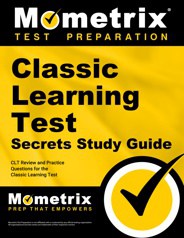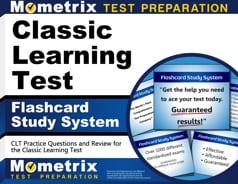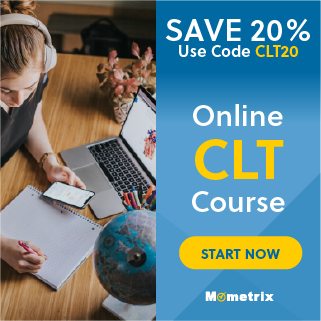The Classic Learning Test (CLT) was developed in 2015 as an alternative to the SAT and ACT college entrance exams. Designed to address bias issues found within the SAT and ACT delivery method, the CLT tests a student’s intellectual aptitude, achievement, and moral reasoning, focusing on logic, reason, and reading.
Click “Start Test” above to take a free CLT practice test, and check out our premium-quality CLT test prep resources by clicking the links below!
About the CLT Exam
There are some things you should consider before deciding to study for and take the CLT.
First, the CLT is not a commonly accepted entrance exam at most colleges and universities in the United States. The colleges where this exam is accepted tend to be smaller private and religious educational institutions. However, its appeal in its non-traditional examination subjects and the ability to use the remote-proctor option has increased its popularity.
Second, the exam is online only at a designated partner school testing center or at home, using a remote proctor. The lack of testing options could be prohibitive if you do not have easy access to a computer, the internet, or other required technology. Some test centers provide the exam device, but most do not. If your school requires you to provide the device, you may bring your laptop, desktop, or tablet.
CLT Eligibility
The CLT exam is promoted as a college entrance examination for high school juniors and seniors. However, the exam is open to candidates who have completed high school and have yet to attend college.
Outline
The CLT contains 120 multiple-choice questions and has a time limit of 2 hours.
The questions are based on a liberal arts education, with questions about human nature and the physical world, lessons from history, and universal mathematical concepts.
The exam is split into three sections, with an optional unscored essay for in-person test administrations.
1. Verbal Reasoning (40 questions)
In this section, which is timed at 40 minutes, you will be asked to read four passages that are taken from classic literature and answer the questions that follow.
Each passage is connected to ten questions, which are designed to assess your understanding of the passage as a whole, your knowledge of the details of that passage, and your ability to identify relationships between different passages. Additionally, you will be asked to analyze the elements of the text (figurative language, analogies, cause-and-effect) and interpret that information based on the evidence presented in the text.
2. Grammar and Writing (40 questions)
In this section, which is timed at 35 minutes, you will be asked to read four passages and answer the questions that follow.
Each passage is connected to ten questions, which evaluate your knowledge and understanding of sentence structure, sentence style, word choice, grammar agreement, and punctuation and sentence structure. The writing questions examine your ability to identify and correct errors, while the grammar questions assess your ability to identify and correct agreement, punctuation, and sentence structure.
3. Quantitative Reasoning (40 questions)
In this section, which is timed at 45 minutes, the questions are split into three areas:
These questions assess your understanding of arithmetic, operations, and algebraic expressions and equations.Geometry (14 questions)
These questions evaluate your knowledge of coordinate geometry, the properties of shapes, and trigonometry.
Mathematical Reasoning (16 questions)
These questions test your ability to use logic and solve word problems.
A list of math formulas is provided, and you will be able to access it throughout this section.
Optional Essay
(Not available for the remote-proctored CLT)
If you choose to complete the essay section, you have 30 minutes to answer one prompt. While the essay is not scored and not included in your overall results, the text of your written response is included with your test results. The essay enables you to provide colleges with a sample of your writing ability under a time limit.
Check Out Mometrix's Classic Learning Test Study Guide
Get practice questions, video tutorials, and detailed study lessons
Get Your Study Guide
CLT Online Prep Course
If you want to be fully prepared, Mometrix offers an online CLT prep course designed to give you everything you need to succeed!
Here’s what you’ll find in the CLT course:
- 70+ Review Lessons Covering Every Topic
- Over 500 CLT Practice Questions
- 220+ Video Tutorials
- 300+ Digital Flashcards
- Money-back Guarantee
- Mobile Access
Everyone learns differently, so we’ve tailored the CLT online prep course to ensure every learner has what they need to prepare for the CLT exam.
Click below to check it out!
Registration
Before registering for the CLT, you will need to decide which mode of delivery works best for you.
The exam is offered throughout the year (including the summer!), whether you take it at home or in-person at a partner school. You can find specific test dates on CLT’s website.
To register for the CLT, create an account on the CLT website. Registration is only available online unless you take the exam through your high school. If you take the exam at school, your school counselor or advisor will complete your registration.
Once you’ve created your account, select the test type (remote or on-site) and test date to register, and pay the $69 fee. The registration fee is payable online only by credit or debit card. Some colleges offer a fee waiver for the CLT, and financial assistance for the exam is provided to those who qualify through the Classic Learning Test website. You must complete registration and pay for the exam before the registration deadline.
The registration deadline for remote-proctored exams is usually a week or more before the test administration date. For in-person exams, the deadline is about a month before the testing date.
Test Day
On the day of your exam, you should report to the testing location or sign in to your online account at least 30 minutes before your examination time. You will be asked to present a valid, government-issued identification card and complete the pre-test activities.
In-person Testing
When you report to the partner school testing center, present your ID and testing equipment, if required.
Outside resources, cell phones, and anything that might be considered a recording device (including smart watches) are not allowed. Calculators are not allowed, nor are they needed for the CLT. Scratch paper is provided, and you can bring a pen or pencil.
After you check in, the test administrator will lead you to your assigned seat. You then have a few minutes to set up your equipment and prepare for the exam. If you have issues connecting to the internet or loading the exam to your computer, consult the test facilitator for options.
Remote Testing
Before checking in for your exam, run an internet connection speed test on your computer to ensure an issue-free exam session. Make sure your area is free from distractions and not in a place where other people are present. Clear your working space of reference materials and cell phone, and disconnect secondary screens. You are allowed up to six pages of blank paper and a writing utensil.
The proctor will inspect your exam space and scratch paper via your webcam before your exam begins.
CLT Test Scores
Each question on the CLT is worth one point. If you answer a question incorrectly, that question receives zero points.
There is no passing or failing score for this test; your college of choice will decide what scores they accept.
Your score report and student analytics will be available within three weeks of taking the test. Your score report includes a student analytics report that analyzes your results and performance in-depth.
If you are happy with your results, you can send them directly to any college or university!
Check Out Mometrix's Classic Learning Test Flashcards
Get complex subjects broken down into easily understandable concepts
Get Your Flashcards
Study Tips
How to Study Effectively
Your success on CLT test day depends not only on how many hours you put into preparing but also on whether you prepared the right way. It’s good to check along the way to see whether your studying is paying off. One of the most effective ways to do this is by taking CLT practice tests to evaluate your progress. Practice tests are useful because they show exactly where you need to improve. Every time you take a free CLT exam practice test, pay special attention to these three groups of questions:
- The questions you got wrong
- The ones you had to guess on, even if you guessed right
- The ones you found difficult or slow to work through
This will show you exactly what your weak areas are and where you need to devote more study time. Ask yourself why each of these questions gave you trouble. Was it because you didn’t understand the material? Was it because you didn’t remember the vocabulary? Do you need more repetitions on this type of question to build speed and confidence? Dig into those questions and figure out how you can strengthen your weak areas as you go back to review the material.
Answer Explanations
Additionally, many CLT practice tests have a section explaining the answer choices. It can be tempting to read the explanation and think that you now have a good understanding of the concept. However, an explanation likely only covers part of the question’s broader context. Even if the explanation makes sense, go back and investigate every concept related to the question until you’re positive you have a thorough understanding.
Comprehend Each Topic
As you go along, keep in mind that the CLT practice test is just that: practice. Memorizing these questions and answers will not be very helpful on the actual test because it is unlikely to have any of the same exact questions. If you only know the right answers to the sample questions, you won’t be prepared for the real thing. Study the concepts until you understand them fully, and then you’ll be able to answer any question that shows up on the test.
Strategy for CLT Practice
When you’re ready to start taking practice tests, follow this strategy:
- Remove Limitations. Take the first test with no time constraints and with your notes and CLT study guide handy. Take your time and focus on applying the strategies you’ve learned.
- Time Yourself. Take the second practice test “open book” as well, but set a timer and practice pacing yourself to finish in time.
- Simulate Test Day. Take any other practice tests as if it were test day. Set a timer and put away your study materials. Sit at a table or desk in a quiet room, imagine yourself at the testing center, and answer questions as quickly and accurately as possible.
- Keep Practicing. Keep taking practice tests on a regular basis until you run out of practice tests or it’s time for the actual test. Your mind will be ready for the schedule and stress of test day, and you’ll be able to focus on recalling the material you’ve learned.
FAQs
Q
How many questions are on the CLT exam?
A
There are 120 multiple-choice questions on the exam.
Q
How long is the CLT exam?
A
The time limit for the exam is 2 hours.
Q
What colleges accept the CLT test?
A
Hundreds of colleges across the United States and Canada accept CLT test scores. Click below to see the current list of CLT partner colleges.
Q
What is the passing score for the CLT?
A
There is no set passing score for this exam.
Q
How much does the CLT exam cost?
A
The examination fee is $69.



